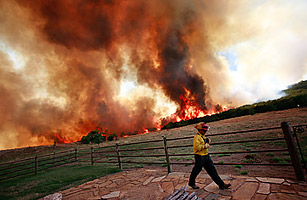
A few weeks ago, my neighborhood was abuzz with the news that coyotes might be savaging the area’s cats. That was followed by the worrisome sight of hawks circling a neighbor’s newly installed backyard chicken coop, the latest rage in suburban pioneer life. But then, on Sunday, neighbors dropped their rakes and hedge cutters, gathering in driveways to wonder what was the source of that large, smokey cloud above the treetops just a mile away.
It was a wildfire and just the latest reminder that, despite the corner Starbucks, the nearby manicured soccer fields and jogging trails along the creek, we live in the Texas wilderness.
A 100-acre wildfire was raging on the western edge of Silicon Hills, just a stone’s throw from Motorola’s Austin plant and in one of city’s comfortable, friendly neighborhoods where live oaks and junipers — called cedar trees by the locals — flourish on the picturesque rocky land. Named after creeks and old ranches — Lost Creek and Circle C, The Hills of Barton Creek and Steiner Ranch — these fast-growing, western developments were warned eight years ago that wildfires could pose a threat. A 2003 Federal Emergency Management Agency risk assessment study said 5,000 acres of west Austin were at risk for extreme fire danger and 72,000 acres of Travis County, home to the capital city, were labeled a high wildfire danger.
But spring in Central Texas is usually a wet affair, usually a time to worry if violent hailstorms will flatten fledgling vegetable garden or scatter the blooms off the Hill Country peach trees. This year is different. Dry, sunny days with low humidity and northern breezes have made for glorious California-style days, but then the wind shifts and hot southern winds bring equally dry, but torrid air up from the Chihuahua desert south of the border. The vast open grasslands of West Texas are tinder and the fires have marched steadily eastward, fed by manmade sparks, some accidental, others more sinister, plus lightning strikes from too-brief storms that brew up when cool and hot air clash. Since Jan. 1, according to the Texas Forest Service, there have been over 800 fires across the state and, as of the latest count, 1.4 million acres have burned in the midst of the worst drought in the record books. This week, in both east and west Texas, in rural and developed areas, creeping closer to major population centers in central and northern Texas, according to the forest service, one of the worst destroying 150,000 acres just 70 miles southwest of Fort Worth near Possum Kingdom Lake.
Sunday’s Austin fire came on one of those glorious, dry sunny days, but smartphones quickly replaced garden tools as the smoke rose. The neighborhood chat room lit up. One resident reported she had seen the flames from the soccer field. Another linked to Twitter photos of the burning Scenic Brook neighborhood, just a mile away. Emergency sirens — more than the usual two or three heard after a Sunday afternoon crash on the road to the lakes — filled the air for more than an hour as over 150 firefighters responded to the quickly spreading fire. Eyes turned skyward at an unfamiliar sight: two C-130 transport planes, flying slow and low above our trees as they prepared to dump 3,000 gallons of retardant on the blaze. Police and EMS helicopters equipped with buckets dipped into the retaining pond at the Motorola plant for what looked from a distance to be thimblefuls of water.
As the sun set, the winds began to die down and the 100-acre fire was contained. The fire had inflicted an estimated $5 million in damage, consumed 11 homes and scorched another 10. Evacuated residents waited for word they could return. Area neighborhood associations launched an online effort to gather store gift cards to help neighbors deal with the loss. And a homeless man was arrested and charged with arson. Michael Weathers, 60, had been cooking his breakfast at a makeshift campsite in an undeveloped, wooded corner of the rocky landscape.
Usually, in spring, we suburban Austinites are busy googling “how to grow tomatoes.” This spring, a more likely search is “how to grow a firewise landscape” — so many native and imported species, notably those ubiquitous cedar trees, are like Molotov cocktails masquerading as green eye candy in our backyards. And while Mother Nature offers no relief in the form of rain, Texas leaders are leaping into the breach. Gov. Rick Perry — no stranger to arson since he was forced from the Governor’s Mansion in 2008 by a manmade fire — declared he will support stiffer sentences for arsonists, up to life in prison. “Someone, I don’t care if they are homeless or what, if they set a fire, the punishment needs to be stiff,” Perry said. “You are talking about people’s lives here.”
See TIME’s Pictures of the Week.
See the science of wildfires.